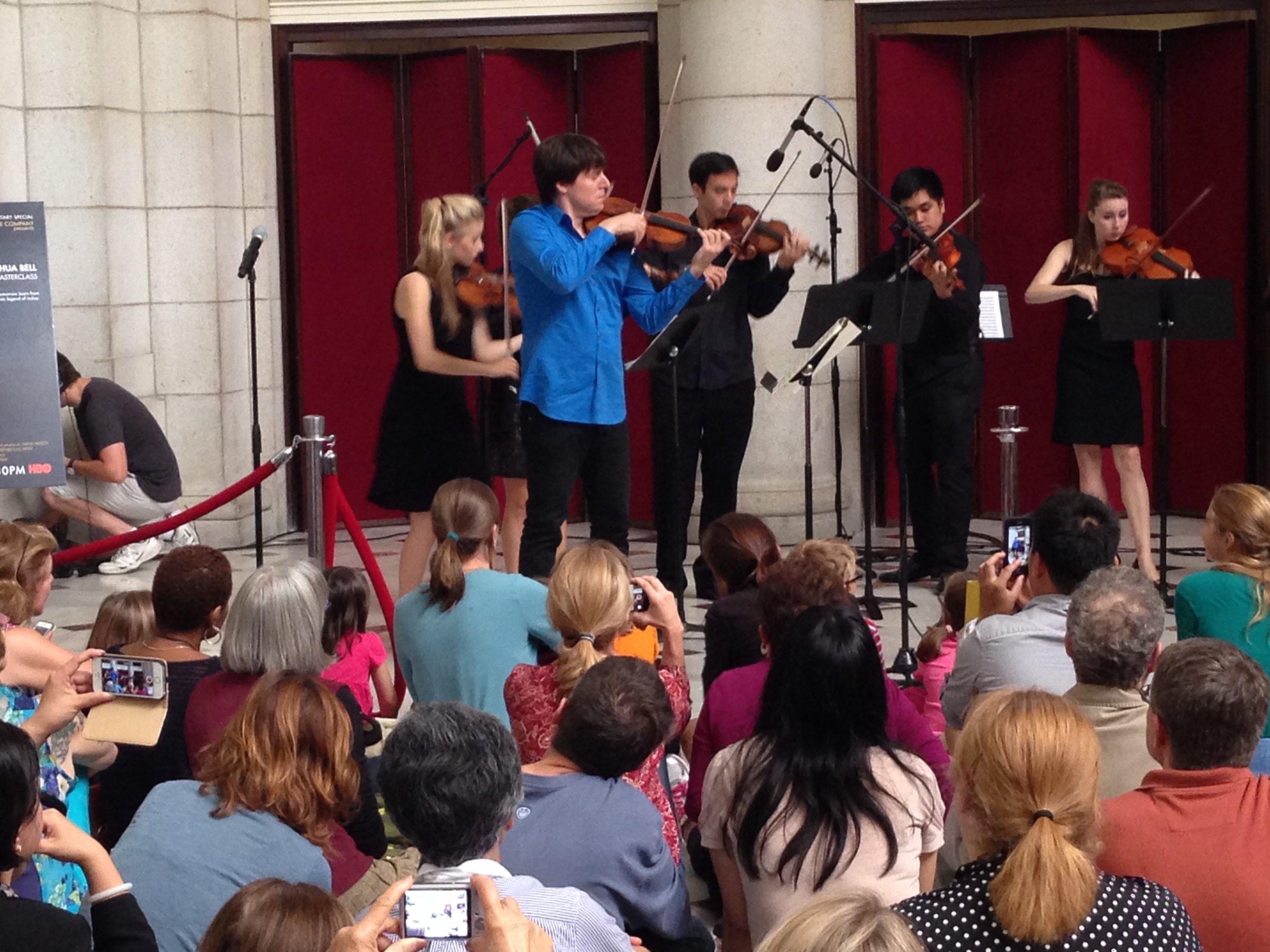
At first glance, Joshua Bell’s violin performance in Union Station in Washington, D.C. Tuesday afternoon bears no resemblance to his famous subway performance seven years ago.
In 2007, as part of a social experiment for a Washington Post magazine article by Gene Weingarten, the renowned violinist posed as a street performer in the Metro to see if hurried commuters could recognize beauty in their midst. He wore a baseball cap, stood by the escalators in the L’Enfant Plaza Metro station in D.C., and opened his violin case for tips. (The case, by the way, that normally houses his multi-million dollar Stradivari violin.) To make a long story short: almost no one noticed him.
Today, Bell is once again playing in a train station, but this time he’s made sure people will notice. His publicist Jane Covner said that it was supposed to feel “impromptu,” but there’s nothing spontaneous about this. The performance was publicized; there’s a designated area for press marked off with red velvet ropes, and there are chairs and microphones set up where Bell performs. People begin arriving over an hour before he’s due to play, and by 12:30, there are hundreds of spectators packed into the main hall of Union Station, sitting on the hard floor, trying to squeeze close to the front along the edges of the room, and some even climbing on construction scaffolding to see over the mass of people.
Compare this to the scene in the train station seven years ago, when in his piece about the stunt, Gene Weingarten lamented, “There was never a crowd, not even for a second.”
Today Bell is playing with nine students from the National YoungArts Foundation to promote an upcoming HBO special entitled “Joshua Bell: A YoungArts MasterClass” and his new Bach album out today. So while 2007 was, according to Weingarten, an experiment in “context, perception and priorities — as well as an unblinking assessment of public taste,” today was all about Bell. His documentary, his album, his performance, his celebrity.
Weingarten took the stage first, appraised the hundreds, possibly thousands of people waiting patiently for Bell—some of whom had traveled from well outside the city to come see him play — and said, “This is a lot better than the first time. A lot better, trust me.”
Better, that is, because people were actually paying attention. This performance is “a do-over for the people in Washington,” Covner said. “Not a do-over for [Bell].” And some of those Washingtonians agreed. Weingarten asked for a show of hands how many people in the audience were some of the “morons” that passed by Bell in 2007; four hands went up. “We accept your apology,” Weingarten deadpanned.
Finally, Bell and his accompanists take the stage. They begin with the first movement of the Bach violin concerto. After the 2007 performance, Weingarten wrote, “There are six moments… that Bell finds particularly painful to relive: ‘The awkward times,’ he calls them. It’s what happens right after each piece ends: nothing. The music stops. The same people who hadn’t noticed him playing don’t notice that he has finished. No applause, no acknowledgment.”
Today, after first movement, the station echoes with booming applause, whoops and cheers. Bell beams as he says, “This is more like it!”
Then, looking out at the impressive crowd, he says, “The only thing I regret is we don’t have an open violin case for tips this time.” (Last time, he made a total of $32.17.)
But how can this performance really be seen as a redo of the last one? Yes, it’s in a train station (albeit a much finer one than L’Enfant Plaza), but the 2007 performance was about whether true artistry could be appreciated without fanfare in ordinary spaces. And while Union Station may not be a grand concert hall, today people came knowing they were going to experience something beautiful, which itself defeats the entire question Weingarten initially posed: “In a banal setting at an inconvenient time, would beauty transcend?”
So today’s performance was not a redo; it was a reimagining. Bell didn’t like the answer he found last time, so today he created a different one. He wanted to prove that art could transcend, if only you give people a little nudge.
“I think the whole idea is that if you give people a chance to listen to music and let them concentrate, then it means something,” Bell told TIME afterwards. “And this shows even in a train station that people can be totally focused.”
Finally, almost a decade later, Bell got the answer he was looking for when he first donned his baseball cap and descended into the Metro.
“I thought of it as closure,” he says. “It was a perfect end.”
Then he laughs: “I don’t see myself ever doing this again.”
More Must-Reads From TIME
- The 100 Most Influential People of 2024
- How Far Trump Would Go
- Scenes From Pro-Palestinian Encampments Across U.S. Universities
- Saving Seconds Is Better Than Hours
- Why Your Breakfast Should Start with a Vegetable
- 6 Compliments That Land Every Time
- Welcome to the Golden Age of Ryan Gosling
- Want Weekly Recs on What to Watch, Read, and More? Sign Up for Worth Your Time
Write to Tessa Berenson at tessa.Rogers@time.com